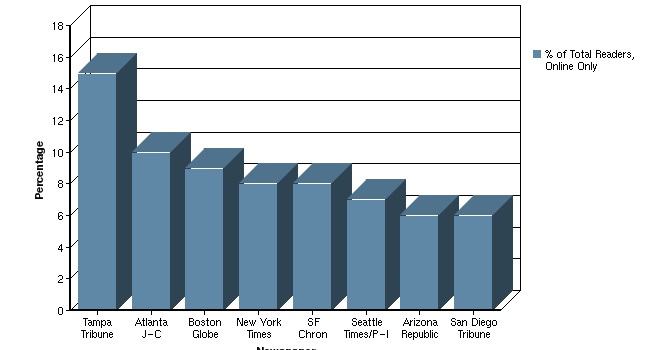Many in the newspaper industry today feel they are trapped in a paradox. While many publications–particularly large metro dailies–are suffering from declining circulation and softening ad revenue, their websites are growing. Unfortunately, internet news is not yet a major economic engine that will make up for the pressure on print revenues, or will bring the kind of economic return to which newspapers and Wall Street are accustomed.
In an effort to grapple with this challenging environment, the industry is looking at alternative measures of readership that somehow reflect that the audience for the news that newspapers produce is bigger than ever. The solution they are trying to promote is something that combines both print and online audiences. And new numbers show that online consumers add tens of thousands of new readers to the average paper’s audience, which, in theory, can give advertisers a bigger pool of potential consumers. The combined number is often called Total Audience.
Although there has been some experimentation with this approach to measuring readers, Scarborough Research just published its first detailed report on integrated online and print newspaper audiences in August. And in early October, the Newspaper Association of America (NAA), with data pooled from Nielsen/Net Ratings and Scarborough, released the Newspaper Audience Database (NAdbase), an extensive compilation of print and online demographic figures for 100 markets.
The gist of the findings is that the ranks of those reading newspapers online are growing. And significantly for advertisers, the Scarborough report finds that these online readers are younger and more affluent than their print-only counterparts.
In asking a random sample of adults whether or not they read a print or online newspaper in the last seven days, Scarborough found that 5.5% of the average paper’s total readership was composed of online-only consumers. Of the 25 local markets sampled, the Tampa Tribune was the most successful in attracting online-only readers to its news website, with 15% (162,747 readers) of its total audience reading just an online version. Trailing behind was the Atlanta Journal-Constitution (224,484 readers) with 10% of online-only readers and the Boston Globe (197,453 readers) followed at 9%.

The market with the papers having the weakest online-only audiences was Denver with the Denver Post and Rocky Mountain News at 2%. Papers in eight other cities — including the Miami Herald and Los Angeles Times — came in just above them with 3% of online-only readers.
The Washington Post led the pack in so-called integrated readership, with 25% of their total audience consuming both the print and online version. The New York Times and the Boston Globe came in next with duplicated audience levels of 22% and 21%, respectively. The lowest integrated readership figure was 9%, found at papers such as the Philadelphia Inquirer and the St. Petersburg Times.

These changes in audience measurement are also not limited to merging the print and online newspaper consumers. Nielsen Media Research, the leading provider of television ratings, recently announced its plans to acquire the remaining 39.5% of NetRatings’ shares. The company will start measuring audiences for television programming delivered through both the TV and computer screens. Nielsen’s purchase of NetRatings, like the Scarborough report, is part of an attempt to incorporate “new media” and “old media” consumers of the same basic product. If indeed it is perceived as a more accurate way of measuring audiences in a steadily fragmenting media universe, it could prove to be a crucial tool for advertisers and a major selling point for news organizations. What is not clear is whether the way advertising works online is so different from the way it does in older media that advertisers will find combining their audiences useful.


